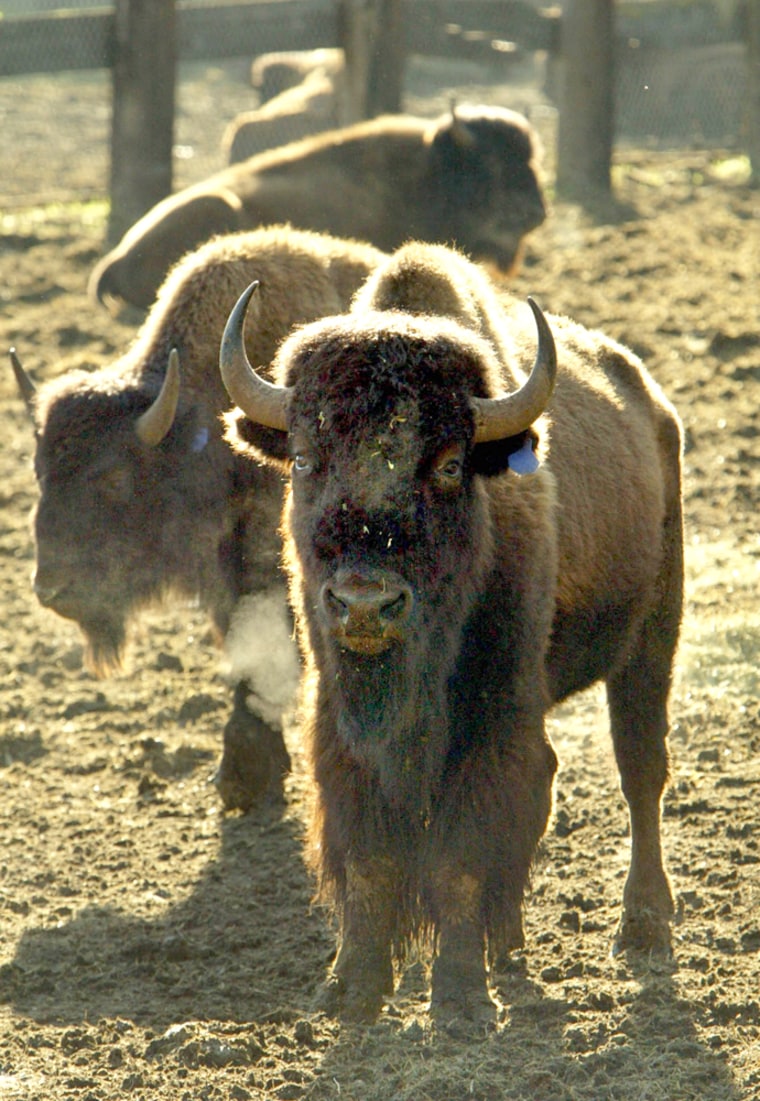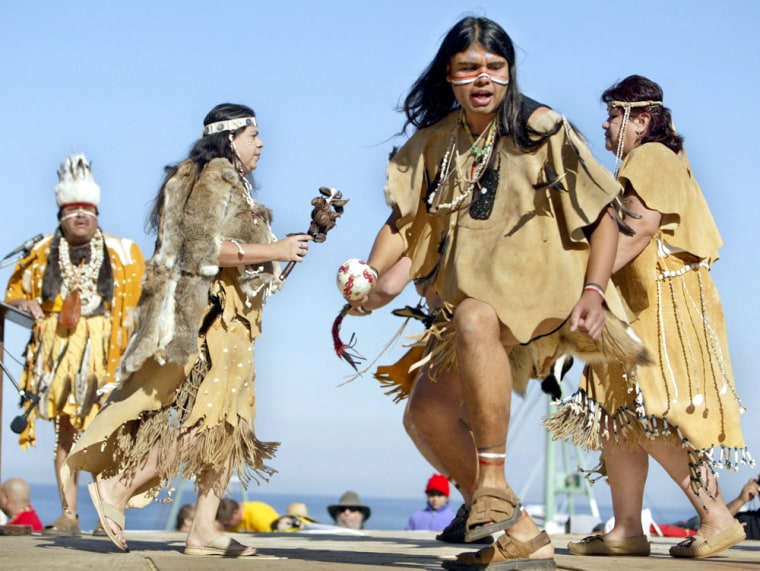Like so many settlers of this state, they came from sturdy midwestern stock, not really meant for the sun and salt air but lured out here by the silver screen.
They never became stars, of course. Once Hollywood was done with them, they were stranded, with no way home. But surprisingly, they managed to eke out a new life for themselves here. In fact, they thrived all too well -- all over the verdant slopes, delicate shores and winding roadways of Santa Catalina Island.
Fourteen buffalo that were shipped here about 80 years ago to play bit parts in a silent film spawned a herd that quickly grew to as many as 500 at one point.
On Wednesday, about 100 were rounded up to make the return trip their ancestors never made -- to a Lakota Indian reservation in South Dakota, in an arrangement designed to relieve the overstressed island and to replenish the thinning ranks of bison in their native Great Plains. In a ceremony to see them off, a leader of Catalina's indigenous Tongva tribe raised a large feathered talisman to bless the beasts.
"This is a very special day for these four-legged animals," said Jimi Castillo, a chaplain with a pewter-colored ponytail, "returning home where they belong."
As he spoke, the steel barge waiting to ferry the buffalo across the 22-mile channel to the mainland -- the first leg of a 30-hour journey to the Plains -- heaved gently in the Pacific surf.
The tremendous undertaking -- enabled in part by a grant from another California tribe, the casino-wealthy Morongo Band of Mission Indians -- highlights the challenges that Catalina's overseers face in preserving its ecosystem.

The 76-square-mile island can be reached only by boat or aircraft, allowing a unique range of rare plants and animals to take hold here. Its rocky coastline and puckered green hills have made it a magnet for tourists, yachters and nature lovers. But over the past several years, the not-for-profit land trust that manages the vast majority of the island has struggled to preserve those attributes.
Several thousand wild goats and pigs -- the nonnative descendants of those brought over by farmers decades ago -- had to be evicted because their grazing was stripping the island of delicate native shrubbery.
The buffalo posed a similar problem. By some accounts, they arrived in 1924 to serve as the scenic backdrop for "The Vanishing American," the screen version of a classic Zane Grey melodrama about an Indian uprising.
Like so many Hollywood hopefuls, though, they ended up on the cutting-room floor, never to be seen in the finished version. Then, apparently, they were simply set free.
Somehow, they made out all right on terrain that was a world apart from their native land. As they adapted -- climbing steep cliffs, running alongside cars, charging the occasional pesky tourist -- they became a beloved feature of the island for its 3,000-some year-round residents as well as its throngs of visitors.
Many underweight
Still, the buffalo were not quite right for the island, said Ann Muscat, president of the Catalina Island Conservancy. They helped out by eating some of the nonnative plants, whose growth the conservancy has tried to thwart -- but they also ate the native ones. And their thick coats would catch the nonnative seeds and spread them far and wide.
The island was not quite right for the bison. They had evolved into a genetically strong herd, never crossing with cattle as so many mainland bison have. "It's a herd that has adapted to live in the wild, and that is very rare," Muscat said. Yet Catalina's climate hurt them -- the dry season coming as they were bearing calves and lactating, leaving many diseased and underweight.
A long-term study determined that Catalina could sustain about 150 buffalo. For a few years, the conservancy shipped small numbers of the animals to auction, where some ended up in breeding programs and others in slaughterhouses.
Last year, the group was approached by the animal rights organization In Defense of Animals, which suggested sending some to the Plains. A first group of about 100 was shipped last fall, with no ceremony, to several Lakota reservations in South Dakota.
Heartened by the success of the first transfer, Catalina decided to ship another group this year, bringing the island's herd to a sustainable 150. Under the agreement, Muscat said, the shipped-out 100 will be in a breeding program and will live out their natural lives.
"They will rejoin a people for whom the bison for centuries have been an important part of culture and life," she said at the ceremony. "This is good for the land, good for the plants and animals that share this land, good for our collective soul."
As a ceremony filled with joyful native dances and somber prayers came to its close, the barge remained empty. An official took the stage to explain that the buffalo were still on their way — some unanticipated delay — and asked the Native American drummers to fill the time with more music.
It would be several more minutes before the convoy of flashing police cars and two long double trailers would appear from around the bend where the base of a cliff met the sea.
"They're coming!" yelled a barge hand.
Freezing weather ahead
Castillo began a song of prayer as the trucks pulled up, and as he keened, a loud knocking came from inside one of the trailers. A horn poked out from one of the air holes; a baleful eye glanced out of another.
Suddenly a question occurred: Did anyone ask the bison about this?
For on Catalina, the sky was a cloudless blue, and pelicans were swooping into the azure waters. A cruise ship hovered just off the coast and a parasailer floated by. Mainland California was just an ambiguous smudge on the horizon, and it was a perfect 75 degrees.
When the bison arrive on the Rosebud Sioux Reservation on Thursday evening, the temperature is expected to start to dip below freezing.
Muscat anticipated the question. The bison who went last year "have done very well," she said. They put on an average of 100 pounds each -- a good thing -- and mixed well with the others, had calves and grew thicker coats to withstand the cold of their native land.
"They had thousands of years to evolve to that," she said. "Eighty years doesn't make that much of a difference.
